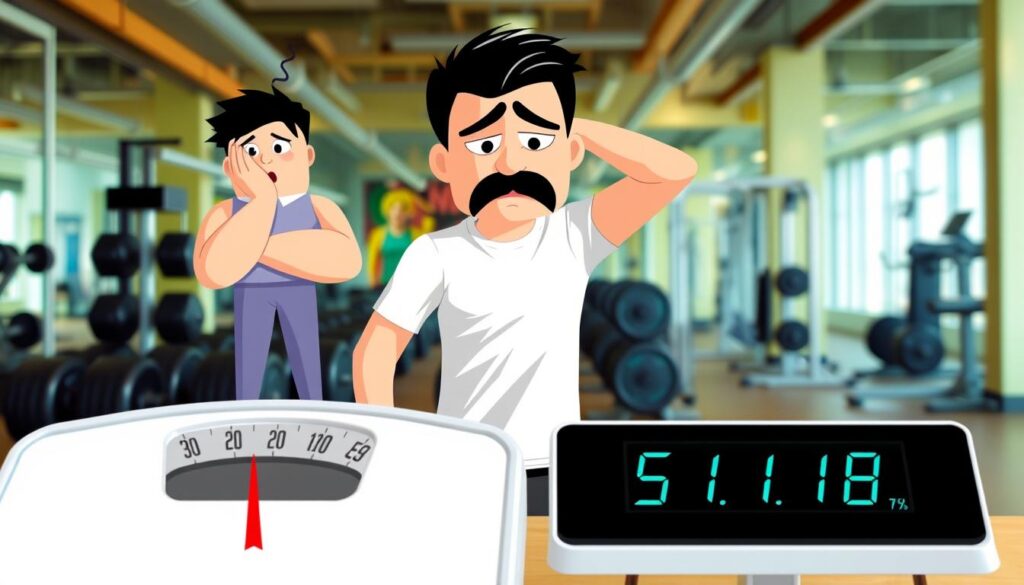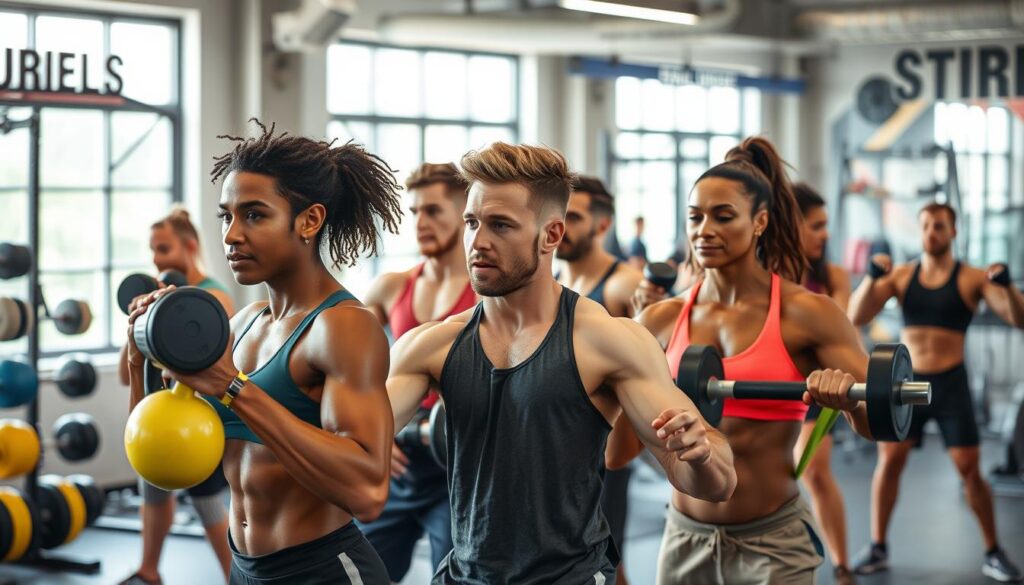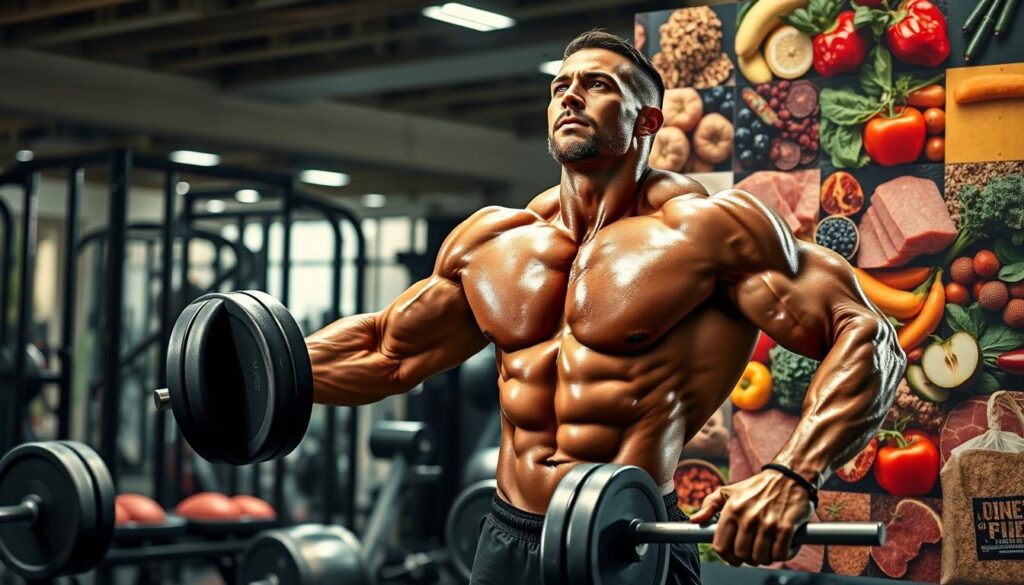If you’re stuck on the scale, body recomposition might be the answer. It’s a way to lose fat and gain muscle at the same time. This method helps you get leaner and more toned, even if your weight doesn’t change much.
Learning about muscle growth and fat loss is key. It helps you reach your body goals.
Key Takeaways
- Body recomposition is the process of losing fat and gaining muscle simultaneously, leading to a change in body composition without significant weight fluctuations.
- Muscle is denser than fat, so the scale may not reflect the progress you’re making in your body transformation journey.
- Proper nutrition, including adequate protein intake, calorie management, and nutrient timing, is crucial for supporting muscle growth and fat loss.
- Strength training and high-intensity interval training (HIIT) are effective exercise strategies for building muscle and burning fat.
- Tracking progress beyond the scale, such as body measurements and body composition analysis, can provide a more accurate picture of your transformation.
Understanding Body Recomposition Basics
Many people want to lose fat and gain muscle at the same time. This is called body recomposition. Research shows it’s possible, especially for those who already do strength training.
The Science Behind Simultaneous Fat Loss and Muscle Gain
Strength training is key for body recomposition. You should focus on big muscle groups. Do three sets of 8-12 reps for each set.
Also, add 3-5 weekly cardio sessions. These can be intense for 75 minutes or moderate for 150 minutes. This helps a lot.
Why Scale Weight Isn’t Everything
The scale might not show your progress right away. This is because muscle weighs more than fat. Look at other signs like how your clothes fit, your energy, and how strong you are.
The Role of Body Composition
The goal is to increase your lean body mass (LBM). This means more skeletal muscle and less body fat. To do this, manage your calories well, eat a lot of protein, and focus on strength training.
| Key Factors for Body Recomposition | Recommendations |
|---|---|
| Strength Training | 3 sets of 8-12 repetitions per major muscle group |
| Cardiovascular Exercise | 3-5 sessions per week (75 mins intense or 150 mins moderate) |
| Nutrition | Balanced diet with 30-35% carbs, 30-35% protein, 30-40% fats |
| Calorie Cycling | Intermittent carb refeed days to support muscle growth and metabolism |
Body recomposition takes time. It depends on your genetics and starting body. But with patience, consistency, and the right plan, you can build muscle and lose fat at the same time.
The Science Behind Muscle Growth
To build muscle, you need to know how it works. Muscle growth happens when you do strength training. This makes your muscles bigger and stronger.
Strength training is key for growing muscles. It makes your muscles work hard. This leads to muscle repair and growth.
Protein is very important for muscle growth. You should eat 1.2 to 1.5 grams of protein for every kilogram of your weight. Eating protein before and after working out helps a lot.
Resting your muscles is also key. They need 24 to 48 hours to get better. Not resting enough can hurt your progress and even cause injuries.
“Strength training is the foundation for building muscle, and proper nutrition and rest are the keys to unlocking your full muscle building potential.”
Knowing how muscles grow helps you plan better. Stick to your plan and be patient. Building muscle takes time and effort.
How Fat Loss Really Works
Many people want to lose unwanted fat. But, it’s important to know how it works. The secret is to have a calorie deficit. This means you burn more calories than you eat.
This helps your body use fat for energy. So, you can lose weight in a healthy way.
Caloric Deficit Explained
To lose fat, you need a calorie deficit. This means you use more calories than you eat. Your body then uses fat for energy, helping you lose weight.
But, it’s key to find the right balance. Too big of a deficit can cause muscle loss.
Metabolic Adaptations During Fat Loss
When you lose fat, your body might change. It might burn calories slower. This makes it harder to lose fat over time.
Things like hormones and stress can also affect how you burn fat.
The Impact of Hormones
Hormones are very important for losing fat and keeping muscle. For example, cortisol can go up when you eat less. This can lead to losing muscle and makes fat loss harder.
Keeping your hormones balanced is key for losing fat and building muscle.
Knowing how fat loss works is important for reaching your goals. By managing calories, adapting to changes, and watching hormones, you can burn fat well. And keep a healthy, strong body.
| Metric | Statistic |
|---|---|
| Muscle loss per decade starting in the 30s | 3% to 5% |
| Protein per meal for muscle building | 25 to 30 grams |
| Strength training recommendation per week | At least 2 days, targeting major muscle groups |
Not Losing Fat But Gaining Muscle: Common Scenarios
If you’re not losing weight, but gaining muscle, don’t worry. The scale doesn’t always show the truth. You might be losing fat while gaining muscle, which can make it seem like you’re not losing weight.
Water retention could be the problem. Too much sodium or stress can make your body hold onto water. Drinking lots of water can help with this.
Sitting too much can also stop you from losing weight. Even if you exercise, sitting a lot can slow down your metabolism. Moving more during the day can help.
Stress can also make it hard to lose weight. High stress levels can make you hungry and gain weight, especially around your belly. Doing yoga or meditation can help lower stress.
| Scenario | Potential Causes | Solutions |
|---|---|---|
| Gaining muscle, not losing weight | – Muscle gain can mask fat loss – Consuming more calories than burning |
– Focus on body composition changes, not just weight – Adjust calorie intake and exercise routine |
| Water retention | – High sodium intake – Stress |
– Increase water intake – Manage stress |
| Weight loss plateau | – Sedentary lifestyle – Stress and high cortisol |
– Increase daily movement – Incorporate stress-reducing activities |
The scale is just one part of your journey. Look at your body’s overall shape and how you’re doing in the gym. With the right plan and patience, you can reach your goals.

Nutrition Strategies for Body Transformation
To change your body, you need good nutrition. You must know about protein, calories, and when to eat.
Protein Requirements for Muscle Growth
Protein is key for muscle. You should eat 1.2–2.0 grams of protein for every kilogram of your weight. For a 150-pound person, that’s 81–137 grams daily.
Eat high-quality proteins like lean meats, eggs, and dairy. Plant-based options are good too.
Calorie Management Tips
Controlling calories is important. Eat 500 calories less than you need to lose fat. But still eat enough for muscle growth.
Do cardio and strength training to help with calorie control.
Timing Your Meals
When you eat matters for muscle and recovery. Try intermittent fasting or calorie cycling. This means changing what you eat based on your workouts.
Eat a lot of protein before or after working out. This helps your muscles grow and recover.
By using these nutrition tips, you can lose fat and gain muscle. This leads to a great body transformation.
| Nutrition Tip | Explanation |
|---|---|
| Increase Protein Intake | Consume 1.2–2.0 grams of protein per kilogram of body weight to support muscle growth. |
| Manage Calorie Deficit | Aim for a 500-calorie deficit below your daily baseline to promote fat loss. |
| Time Your Meals | Strategically time your meals, especially around workouts, to optimize muscle protein synthesis and recovery. |
“Achieving your body transformation goals requires a holistic approach to nutrition, incorporating the right balance of macronutrients, strategic calorie management, and well-timed meals.”
Optimal Training Methods for Results
To get the body you want, the right training is key. You need a mix of strength training and high-intensity interval training (HIIT).
Strength Training is very important. It works big muscles and burns calories. Do strength training 3-5 times a week. Focus on big exercises like bench press, deadlifts, squats, and overhead press. These exercises work many muscles at once, burning more calories and building muscle.
- Compound exercises like bench press, deadlifts, squats, and overhead press activate large muscle groups, burning more calories.
- Aim for 3-5 days of strength training per week to build lean muscle and boost metabolism.
High-Intensity Interval Training (HIIT) is also great for losing fat and growing muscle. HIIT means short, hard workouts followed by rest. It boosts human growth hormone, helping grow muscle and burn fat. Do 15 minutes of HIIT three times a week, switching between hard work and rest.
- HIIT can increase human growth hormone levels, stimulating muscle growth and fat burning.
- Aim for 15 minutes of HIIT three days per week, alternating intense exercise bursts with recovery periods.
By mixing strength training and HIIT, you get a good workout plan. It helps you reach your body goals and get the results you want.

Key Foods That Support Muscle Growth While Burning Fat
To build muscle and lose fat at the same time, you need a good plan. Eating the right foods is key. This includes protein-rich foods, fat-burning foods, and the right foods before and after working out. Let’s look at some important foods for these goals.
Protein-Rich Food Sources
Protein is vital for growing and keeping muscles strong. Here are some great protein sources:
- Eggs: Each boiled or poached egg has 6.28 grams of protein.
- Chicken breast: A 120-gram chicken breast has 35.5 grams of protein.
- Salmon: This fatty fish has 58.5 grams of protein per 227 grams.
- Greek yogurt: 5 ounces of this high-protein dairy has 12-18 grams of protein.
- Lean beef: Pork tenderloin and other lean beef cuts help grow muscles.
- Cottage cheese: Half a cup of low-fat cottage cheese has 14 grams of protein.
- Soybeans: A half-cup of cooked soybeans has 16 grams of protein and healthy fats.
Fat-Burning Superfoods
Adding fat-burning foods to your diet can help too. Here are some top picks:
- Avocado: It’s full of monounsaturated fats that help burn fat.
- Green tea: It has caffeine and antioxidants that boost metabolism.
- Chili peppers: Capsaicin in chili peppers can increase calorie burn.
- Berries: They’re full of fiber and antioxidants, helping control hunger and inflammation.
- Leafy greens: They’re packed with nutrients and low in calories, promoting health.
Pre and Post-Workout Nutrition
Timing your meals around workouts is important. Before working out, eat carbs like oats, quinoa, or a banana. After, eat protein and carbs together, like a whey protein shake with fruit or Greek yogurt with berries.
By eating these foods and planning your meals, you can help your body grow muscle and lose fat.
Progress Tracking Beyond the Scale
The scale doesn’t tell the whole story of your body transformation. It’s important, but it’s not everything. To really see how you’re doing, look at other important signs.
Body measurements like waistline, hip size, and muscle mass are key. They show how your body is changing, even if the scale doesn’t show it.
Progress photos are also very helpful. Take pictures of yourself in the same way often. You’ll see how your body shape and muscle definition change. Seeing these changes can really motivate you.
Getting stronger is another great way to track progress. If you can lift heavier or do more reps, you’re getting better. This shows all your hard work is paying off.
Don’t just look at the scale. Use different ways to track your progress. This will give you a full picture of how your body is changing. It will also keep you motivated on your journey.
| Tracking Method | Benefits |
|---|---|
| Body Measurements | Provides insights into body composition changes beyond just weight |
| Progress Photos | Visually captures changes in body shape, muscle definition, and fat loss |
| Strength Gains | Reflects improvements in fitness level and muscle growth |
By looking at different signs of progress, you can stay motivated. You’ll see your true body transformation and celebrate your victories.
Conclusion
To get the body you want, you need a plan that lasts. This plan should help you lose fat and gain muscle. It’s all about eating right and exercising well.
Don’t rush it. Changing your body takes time. Keep going, even when it’s hard.
Make healthy habits a part of your life. Good food, the right workouts, and a healthy lifestyle are key. This way, you’ll reach your body goals and keep them.
Everyone is different, so don’t get discouraged. Celebrate every small win. Enjoy the journey to becoming your best self.
Stay focused and committed. With the right attitude, you can achieve amazing things. Body transformation is powerful and life-changing.


A Life-Changing Experience with This Weight Loss Supplement (Nagano Tonic)
I’ve always struggled with finding a weight loss solution that actually works for me. Like many, I’ve tried numerous diets, exercise routines, and supplements over the years—some worked for a short time, but nothing ever gave me long-term results. That was until I decided to try the weight loss supplement I found : Link to the Supplement.
From the moment I started using it, I noticed a difference. Not only did I feel more energized, but my cravings also became more manageable. The best part? I started seeing results much quicker than I anticipated! Over the course of just a few weeks, I noticed a significant reduction in belly fat and overall weight loss that I hadn’t been able to achieve before.
What makes this supplement stand out from all the others I’ve tried is how it supports me in my daily routine without any jitters or energy crashes. I’m able to stay focused and motivated, which has made it easier to stay on track with my diet and exercise plan.
This product truly exceeded my expectations, and I feel more confident and healthier than ever before. If you’re struggling with your weight loss journey like I was, I highly recommend giving this supplement a try. It’s been a game-changer for me, and I’m sure it can work wonders for you too!
Contant Them on email .. tonicnagano50@gmail.com
I’ve tried so many weight loss products over the years, but nothing worked like this supplement! Since I started using it, I’ve noticed a big difference in my energy levels and appetite control. In just a few weeks, I’ve lost weight and feel so much better. It’s been easy to stick with, and the results speak for themselves. Highly recommend this to anyone looking to make a real change!
wasn’t sure what to expect, but this weight loss supplement has really impressed me! After just a few weeks of use, I’ve already dropped a few pounds and feel more motivated to stay active. It’s helped curb my cravings and boosted my energy throughout the day. I’m excited to keep going and see even better results. Definitely worth trying!
Reach them on tonicnagano50@gmail.com
I was skeptical at first, but this supplement has truly made a difference in my weight loss journey. I’ve lost weight without feeling deprived or sluggish. My cravings are under control, and I feel more confident in my body. It’s easy to incorporate into my daily routine, and the results speak for themselves. I’m so glad I gave it a try!
Thanks David, i do use the link to make my purchase. you can get too here http://surl.li/iasppy
I’ve tried so many weight loss products, but this one has been by far the most effective. In just a few weeks, I’ve noticed a visible difference in my body and energy levels. It’s helped me stay on track without the constant hunger pangs and cravings. I’m really happy with my progress and can’t wait to see where I’ll be in another month!
This Nagano Tonic has been amazing! In just a few weeks, I’ve lost weight, feel more energized, and my cravings are under control. Highly recommend it!
Thats the link to purchase http://surl.li/iasppy